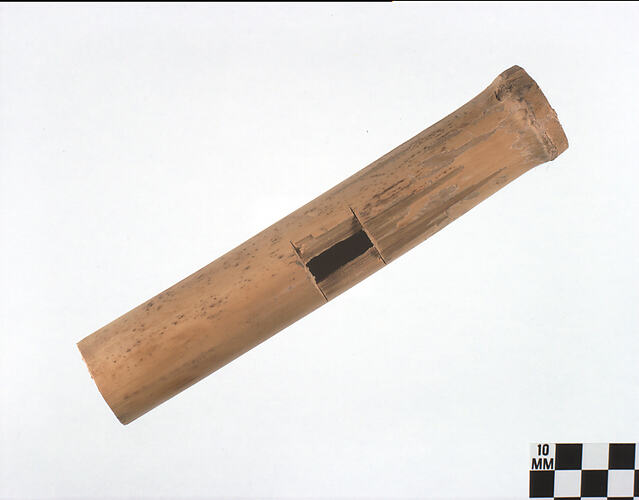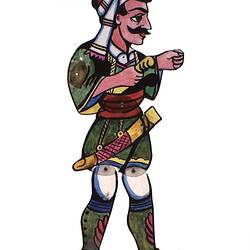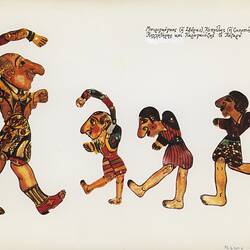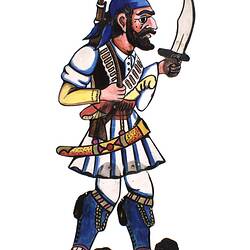Summary
This whistle was made in 1978 by Dimitri Katsoulis at his home in Port Melbourne and used in his subsequent performances in Victoria and in South Australia from 1978 to 1991. Dimitri Katsoulis migrated to Australia in 1974 to escape a regime that repressed Greek artists. He had trained in Greece with theatre and film companies as an actor and technician. A master of the traditional Greek shadow puppet theatre, his performances explored contemporary issues such as the isolation of migrant women and children. Unable to obtain funding and support, he returned to Greece in 1991, leaving his entire collection to the people of Victoria. It includes 32 shadow puppets and around 170 props, set backdrops and technical tools and stage equipment. Dimitri has since returned to Melbourne and assists the Museum to continue to document this rich art form within both local and international contexts.
This bamboo whistle is an instrument that was used by Dimitri Katsoulis for making sound effects during Greek Shadow Puppet Theare performances. The end was covered with cigarette paper and the player would blow. It is a children's toy that Dimitri designed himself. He used it to make sound effects such as the sound the snake made when it attacked people in the play 'Megalexandros [Alexander the Great] and the Cursed Snake'. It is also used as the sound effect for the skirmish which took place before Megalexandros [Alexander the Great] killed the snake. Furthermore, the whistle is used to create a trumpet sound, which is often heard in the Introduction prior to the main play when Karaghiozis and his children march and sing to the trumpet sound as they enter the stage.
Information supplied by Greek Shadow Puppet Theatre master Dimitri Katsoulis, 2007.
Physical Description
A hollow tube of bamboo, pale golden in colour, cut to include a joint at one end and open in the other. About the centre a rectangular hole has been cut to allow the passage of air.
Significance
This collection of puppets, props, stage sets, and technical tools and equipment relating to traditional Greek Shadow Puppet Theatre is unique in Australia and rare in international public collections. The history of Greek Shadow Puppet Theatre, its puppet characters and the methodology of its performance has been recorded in partnership with the puppet master to whom the collection belonged. The collection is highly significant both as documentation of an important cross-cultural, centuries-old art form, and as an example of the transnational migration of cultural activity between Greece and Australia. It is a collection which was created and performed in Greece and Australia from the mid to late twentieth century, by two puppet masters, who transported the tradition between two countries. Abraam Antonakos came to Australia in 1977 to perform the puppet theatre and then deposited the puppets with Dimitri Katsoulis, who had migrated to Australia in 1974. Dimitri's story becomes one of migration experience, cultural maintenance and adaptation, and finally return migration and the discontinuance of this cultural art form in Australia.
More Information
-
Collection Names
-
Collecting Areas
-
Acquisition Information
Purchase
-
Maker
Mr Dimitri Katsoulis, Melbourne, Greater Melbourne, Victoria, Australia, 1978
-
User
-
Classification
-
Category
-
Discipline
-
Type of item
-
overall dimensions
8.8 cm (Length), 3.3 cm (Width), 3.3 cm (Height)
-
Exhibition Collection Management
88 mm (Length), 33 mm (Width), 33 mm (Height)
-
References
[Link 1] Malkin, Michael, R. Traditional and Folk Puppets of the World, A.S. Barnes & Co., Inc., N.J., 1977; Simmen, Rene, The World of Puppets, Elsevier, Phaidon, London, 1975; Hogarth, Ann & Bussell, Jan, Fanfare for Puppets!, David & Charles Publishers Ltd, USA, 1985; Yayannos, A & Ar and Dingli, J. The World of Karaghiozis, 1976
-
Keywords
Cultural Maintenance, Greek Communities, Greek Immigration, Karaghiozis Theatre, Shadow Puppetry, Theatres, Working Life



